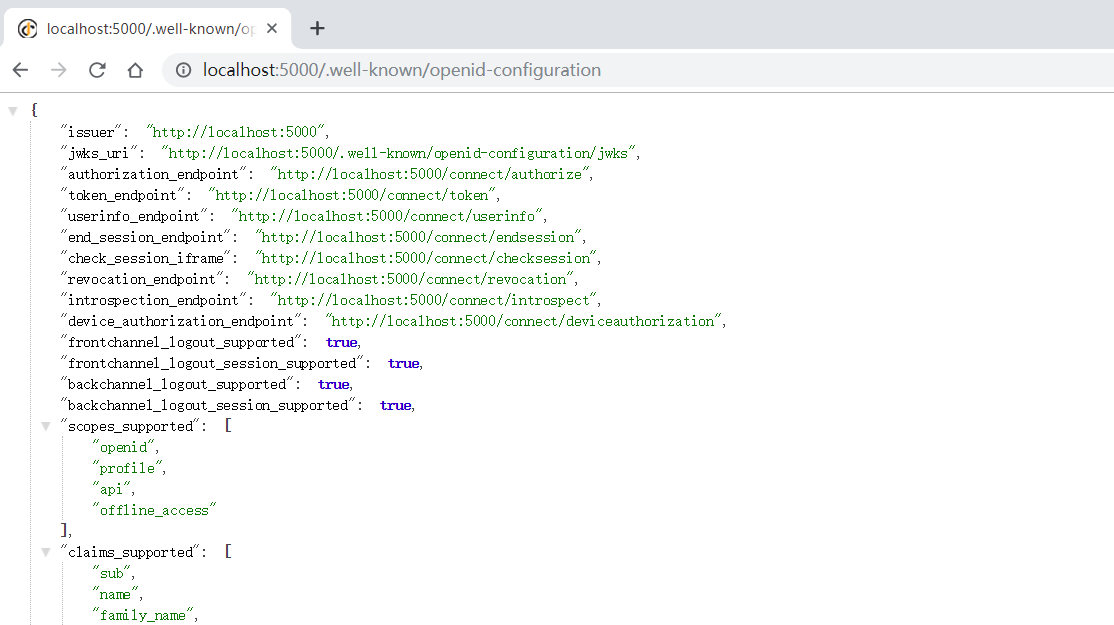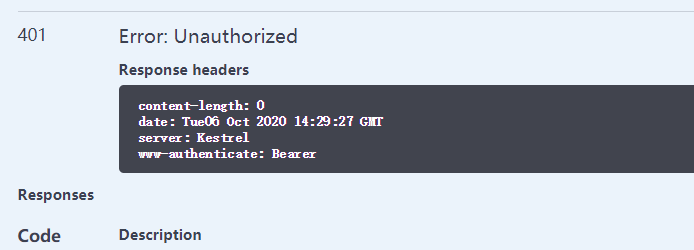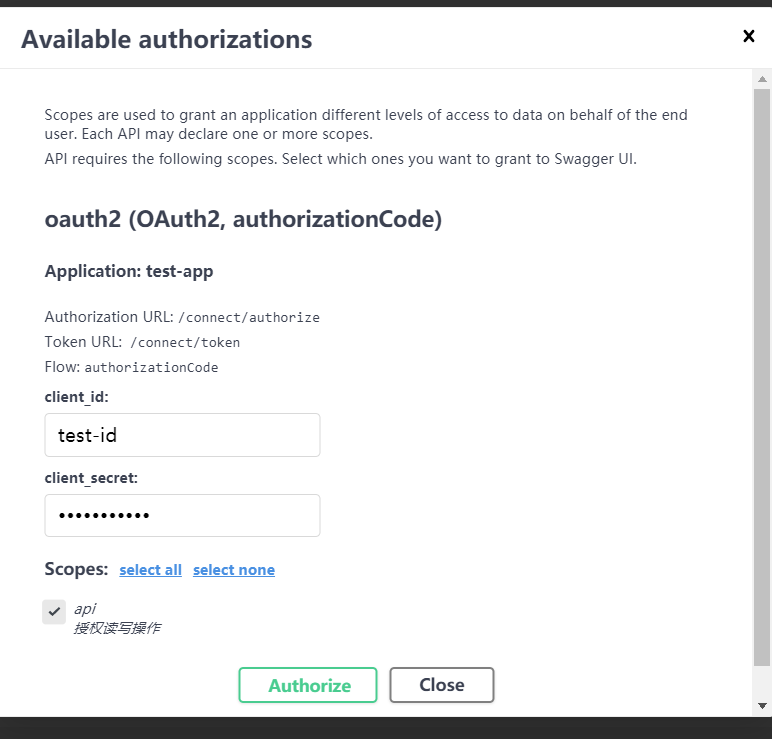最近想整合IdentityServer4跟API,但网上找到的都是各种坑,踩都踩不玩!
花了点时间终于整合好了,记录下。
新建空的asp.net core 项目
使用NuGet安装IdentityServer4最新版4.1.0。安装完成新建Config.cs类。内容如下:

using IdentityServer4; using IdentityServer4.Models; using IdentityServer4.Test; using System; using System.Collections.Generic; using System.Linq; using System.Threading.Tasks; namespace IdsAPI { public static class Config { /// <summary> /// 客户端 /// </summary> /// <returns></returns> internal static IEnumerable<Client> Clients() { yield return new Client { ClientId = "test-id", ClientName = "Test client (Code with PKCE)", RedirectUris = new[] { "http://localhost:5000/resource-server/swagger/oauth2-redirect.html", // Kestrel }, ClientSecrets = { new Secret("test-secret".Sha256()) }, RequireConsent = true, AllowedGrantTypes = GrantTypes.Code, RequirePkce = true, AllowedScopes = new[] { "api",IdentityServerConstants.StandardScopes.OpenId, IdentityServerConstants.StandardScopes.Profile}, }; } /// <summary> /// api资源 /// </summary> /// <returns></returns> internal static IEnumerable<ApiResource> ApiResources() { return new List<ApiResource> { new ApiResource("api","my api") { Scopes ={"api"},//重要,不配置返回 invalid_scope } }; } /// <summary> /// api范围 /// </summary> /// <returns></returns> internal static IEnumerable<ApiScope> GetApiScopes() { return new List<ApiScope> { new ApiScope("api") }; } internal static IEnumerable<IdentityResource> GetIdentityResourceResources() { return new List<IdentityResource> { new IdentityResources.OpenId(), new IdentityResources.Profile() }; } /// <summary> /// 测试用户 /// </summary> /// <returns></returns> internal static List<TestUser> TestUsers() { return new List<TestUser> { new TestUser { SubjectId = "joebloggs", Username = "admin", Password = "123456" } }; } } }
注入IdentityServer4,代码如下:
using System; using System.Collections.Generic; using System.Linq; using System.Threading.Tasks; using Microsoft.AspNetCore.Builder; using Microsoft.AspNetCore.Hosting; using Microsoft.AspNetCore.Http; using Microsoft.Extensions.DependencyInjection; using Microsoft.Extensions.Hosting; namespace IdentityServer4API { public class Startup { // This method gets called by the runtime. Use this method to add services to the container. // For more information on how to configure your application, visit https://go.microsoft.com/fwlink/?LinkID=398940 public void ConfigureServices(IServiceCollection services) { //注入IdentityServer services.AddIdentityServer() .AddDeveloperSigningCredential() .AddInMemoryClients(Config.Clients()) .AddInMemoryApiResources(Config.ApiResources()) .AddTestUsers(Config.TestUsers()) .AddInMemoryIdentityResources(Config.GetIdentityResourceResources()) //4.0版本需要添加,不然调用时提示invalid_scope错误 .AddInMemoryApiScopes(Config.GetApiScopes()); //注入mvc services.AddControllersWithViews(); } // This method gets called by the runtime. Use this method to configure the HTTP request pipeline. public void Configure(IApplicationBuilder app, IWebHostEnvironment env) { if (env.IsDevelopment()) { app.UseDeveloperExceptionPage(); } //添加静态资源引用 app.UseStaticFiles(); app.UseRouting(); //添加IdentityServer app.UseIdentityServer(); app.UseEndpoints(endpoints => { endpoints.MapDefaultControllerRoute(); }); } } }
启动访问 http://localhost:5000/.well-known/openid-configuration 能正常访问即可。

添加Swagge
使用NuGet安装IdentityServer4.AccessTokenValidation跟Swashbuckle.AspNetCore最新版。
新建类SecurityRequirementsOperationFilter,内容如下:
using Microsoft.AspNetCore.Authorization; using Microsoft.OpenApi.Models; using Swashbuckle.AspNetCore.SwaggerGen; using System; using System.Collections.Generic; using System.Linq; using System.Threading.Tasks; namespace IdentityServer4API { public class SecurityRequirementsOperationFilter : IOperationFilter { public void Apply(OpenApiOperation operation, OperationFilterContext context) { //获取是否添加登录特性 //策略名称映射到范围 var requiredScopes = context.MethodInfo .GetCustomAttributes(true) .OfType<AuthorizeAttribute>() .Select(attr => attr.Policy) .Distinct(); if (requiredScopes.Any()) { operation.Responses.Add("401", new OpenApiResponse { Description = "未经授权" }); operation.Responses.Add("403", new OpenApiResponse { Description = "禁止访问" }); var oAuthScheme = new OpenApiSecurityScheme { Reference = new OpenApiReference { Type = ReferenceType.SecurityScheme, Id = "oauth2" } }; operation.Security = new List<OpenApiSecurityRequirement> { new OpenApiSecurityRequirement { [ oAuthScheme ] = requiredScopes.ToList() } }; } } } }
修改Startup中 ConfigureServices方法,增加新的配置:
//身份验证设置有点细微差别,因为此应用提供了身份验证服务器和资源服务器 //默认情况下使用“ Cookies”方案,并且在资源服务器控制器中明确要求“ Bearer” //详细查看 https://docs.microsoft.com/en-us/aspnet/core/security/authorization/limitingidentitybyscheme?tabs=aspnetcore2x services.AddAuthentication(CookieAuthenticationDefaults.AuthenticationScheme) .AddCookie() .AddIdentityServerAuthentication(c => { c.Authority = "http://localhost:5000/"; c.RequireHttpsMetadata = false; c.ApiName = "api"; }); //配置直接映射到OAuth2.0范围的命名身份验证策略 services.AddAuthorization(c => { c.AddPolicy("AuthorizedAccess", p => p.RequireClaim("scope", "api")); }); services.AddSwaggerGen(c => { c.SwaggerDoc("v1", new OpenApiInfo { Version = "v1", Title = "Test API V1" }); // 定义正在使用的OAuth2.0方案 c.AddSecurityDefinition("oauth2", new OpenApiSecurityScheme { Type = SecuritySchemeType.OAuth2, Flows = new OpenApiOAuthFlows { AuthorizationCode = new OpenApiOAuthFlow { AuthorizationUrl = new Uri("/connect/authorize", UriKind.Relative), TokenUrl = new Uri("/connect/token", UriKind.Relative), Scopes = new Dictionary<string, string> { { "api", "授权读写操作" }, } } } }); // 根据AuthorizeAttributea分配是否需要授权操作 c.OperationFilter<SecurityRequirementsOperationFilter>(); });
修改改Configure,增加配置,完整代码如下:
public void Configure(IApplicationBuilder app, IWebHostEnvironment env) { if (env.IsDevelopment()) { app.UseDeveloperExceptionPage(); } //添加静态资源引用 app.UseStaticFiles(); app.UseRouting(); //身份验证 app.UseAuthentication(); app.UseAuthorization(); //添加IdentityServer app.UseIdentityServer(); app.UseEndpoints(endpoints => { endpoints.MapDefaultControllerRoute(); }); //api配置 app.Map("/resource-server", resourceServer => { resourceServer.UseRouting(); //身份验证 resourceServer.UseAuthentication(); resourceServer.UseAuthorization(); // resourceServer.UseEndpoints(endpoints => { endpoints.MapControllers(); }); //Swagger resourceServer.UseSwagger(); resourceServer.UseSwaggerUI(c => { c.SwaggerEndpoint("/resource-server/swagger/v1/swagger.json", "My API V1"); c.EnableDeepLinking(); // Additional OAuth settings (See https://github.com/swagger-api/swagger-ui/blob/v3.10.0/docs/usage/oauth2.md) c.OAuthClientId("test-id"); c.OAuthClientSecret("test-secret"); c.OAuthAppName("test-app"); c.OAuthScopeSeparator(" "); c.OAuthUsePkce(); }); }); }
修改Properties下的launchSettings启动配置文件:
{ "iisSettings": { "windowsAuthentication": false, "anonymousAuthentication": true, "iisExpress": { "applicationUrl": "http://localhost:8950", "sslPort": 44380 } }, "profiles": { "IIS Express": { "commandName": "IISExpress", "launchBrowser": true, "environmentVariables": { "ASPNETCORE_ENVIRONMENT": "Development" } }, "IdentityServer4API": { "commandName": "Project", "launchBrowser": true, "launchUrl": "resource-server/swagger",//初始页 "applicationUrl": "http://localhost:5000", "environmentVariables": { "ASPNETCORE_ENVIRONMENT": "Development" } } } }
新建api控制器:
using System.Collections.Generic; using Microsoft.AspNetCore.Mvc; using Microsoft.AspNetCore.Authorization; namespace API.Controllers { [Route("products")] public class ProductsController : Controller { [HttpGet] [Authorize(AuthenticationSchemes = "Bearer")] [Authorize("AuthorizedAccess")] public IEnumerable<Product> GetProducts() { yield return new Product { Id = 1, SerialNo = "ABC123", }; } [HttpGet("{id}")] public Product GetProduct(int id) { return new Product { Id = 1, SerialNo = "ABC123", }; } [HttpPost] public void CreateProduct([FromBody]Product product) { } [HttpDelete("{id}")] public void DeleteProduct(int id) { } } public class Product { public int Id { get; internal set; } public string SerialNo { get; set; } public ProductStatus Status { get; set; } } public enum ProductStatus { InStock, ComingSoon } }
启动后我们可以看到加了Authorize的方法有一把琐一样的图标

这样的接口需要登录才能正常使用,不登录授权调用返回401,无效授权错误。

点击琐或者Authorize按钮显示如下界面,勾选对应的api名称,

在次点击Authorize会跳转到登录页面,登录在config种配置的用户会跳到授权页面授权后返回api接口页面。


这是完成授权后的界面

在次调用api就能正常调用:

演示源码地址:https://github.com/ice-ko/IdentityServer4-API-Swagger
